
SST CRISP images
CRISP FPI etalons.
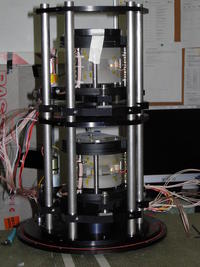 |
CRISP FPI etalons installed in container.
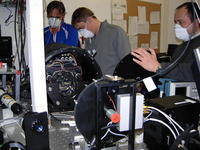 |
Closing up the CRISP FPI container.
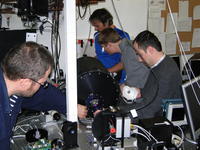 |
During April 2008,
the CRisp
Imaging SpectroPolarimeter (CRISP) was installed at the SST on La
Palma. The tunable filter part of this system is a dual Fabry-Pérot
Interferometer (FPI) system, usable from 510 to 860 nm with
0.3-0.9 nm wide pre-filters. It has a compact telecentric optical
design with a minimum number of optical surfaces and high overall
transmission. Polarization measurements are made by liquid crystal
(LC) modulation and a polarizing beam splitter, located close to the
final focal plane and feeding two 1k×1k-pixel Sarnoff CCD
cameras. MOMFBD
image restoration is aided with a third CCD providing broad-band
images synchronized with the two narrowband images and recorded
through the pre-filter of the FPI system. The optimization of the FPI
system is described by Göran Scharmer
(2006,
A&A 447, 1111), the overall design and details of CRISP will
be described in a forthcoming publication and also provided on our
web site.
CRISP λcore-5 pm image.
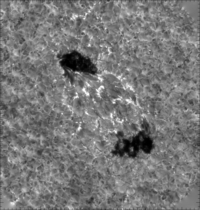 |
CRISP continuum image.
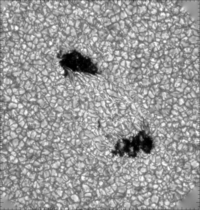 |
Tomas Hillberg observed two large pores of opposite polarities using
CRISP on 22 April 2008. The two CRISP narrowband images shown here
(jpeg by clicking on the thumbnails, 1000 km tickmarks; in FITS format
below, 0.071 arcsec pixels) are recorded at pm from the line
core and in the nearby continuum, resp., of the Zeeman-sensitive
Fe I line at 630.2 nm. The filter passband is about
6.5 pm at this wavelength. The CRISP tuning sequence used
scanned the line in 11 wavelength positions plus one continuum
wavelength during < 11 s, while cycling through 4
polarization states. Such data, consisting of a total of 338 images
from the broadband camera and 334 polarimetric images each from the
two CRISP narrowband cameras, was processed as a single MOMFBD data
set by Mats Löfdahl. The restored polarimetric images, each based
on 7 exposures, demonstrate impressive spatial resolution at or near
the diffraction limit of the telescope (0.16 arcsec at this
wavelength) and very high polarimetric sensitivity.
This is presently the most highly resolving solar spectropolarimeter
in the world as regards spatial resolution. Polarimetric analysis of
the data is under way.
The construction of CRISP was made possible thanks to a grant
from the Marianne and Marcus Wallenberg Foundation.
CRISP
continuum image in FITS format, 3.6 MB.
CRISP
λcore-5 pm image in FITS format, 3.6 MB.
Time-stamp: <2018-10-09 13:55:38 mats>






